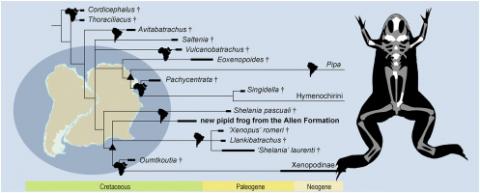Raúl O. Gómez
2 016
Cretaceous Research Volume 62, July 2016, Pages 52-64
Pipid frogs are fully aquatic frogs that today inhabit freshwater environments of southern continents on both sides of the Atlantic Ocean, with a fairly good fossil record dating back to the Cretaceous. Here I report on fossils from the Allen Formation (upper Campanian–lower Maastrichtian), Río Negro Province, Argentina, that are ascribed to a new genus and species of pipid. In order to assess the evolutionary relationships of the new taxon, which is represented by sphenethmoids, otic capsules, ilia, humeri, and vertebrae, cladistic analyses of a data matrix of 165 osteological characters scored for 36 taxa were performed. The results are congruent with previous hypotheses of pipoid interrelationships and consistently place the new taxon as part of the lineage today represented by the African xenopodines. Temporal calibration of the phylogenetic tree based on the fossil record imply that the origin and early diversification of crown-group Pipidae might have occurred during the Early Cretaceous, prior to the final breakup of western Gondwana. This study highlights the importance of including fossils, even fragmentary ones, directly in phylogenetic analyses in order to disentangling how, when, and where pipid frogs diversified.

